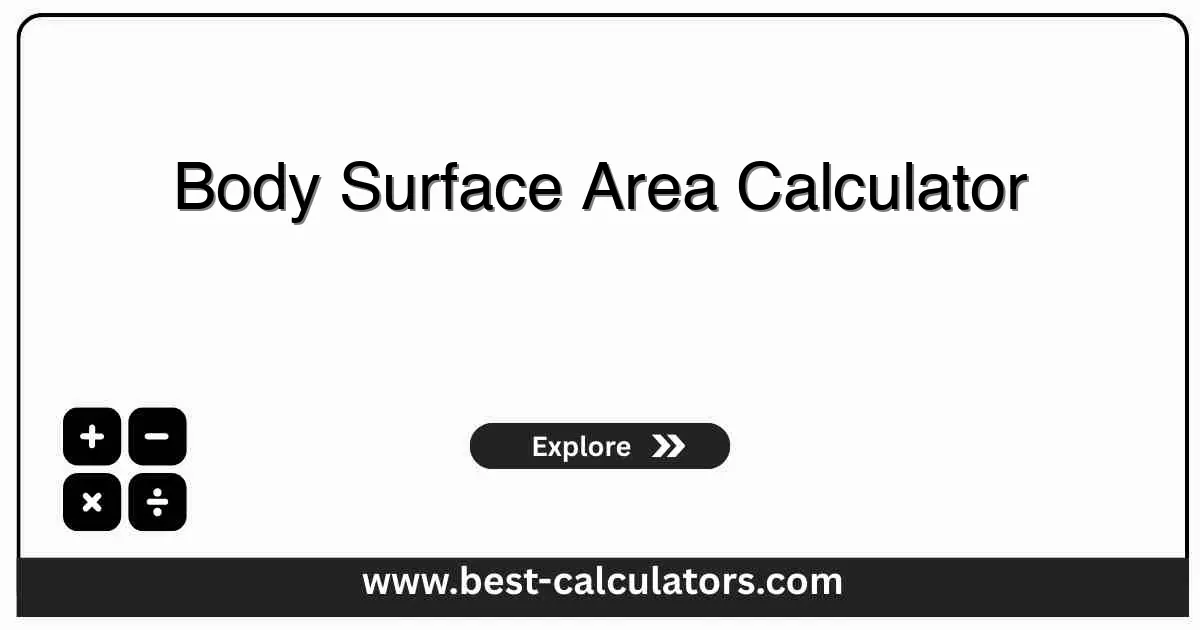Body Surface Area Calculator - Calculate BSA
Free body surface area calculator using multiple formulas for accurate medical dosing and clinical calculations
Body Surface Area Calculator
Results
What is a Body Surface Area Calculator?
A Body Surface Area Calculator is a free medical tool that calculates total body surface area in square meters using validated formulas like Mosteller, DuBois, or Haycock. BSA is essential for accurate medication dosing, chemotherapy calculations, burn assessment, cardiac index determination, and renal function adjustments in clinical medicine.
This calculator works for:
- Medical dosing - Calculate drug doses based on BSA
- Burn assessment - Determine burn severity and fluid needs
- Cardiac calculations - Compute cardiac index and output
- Chemotherapy - Determine accurate cancer treatment doses
To assess overall health metrics, check out our BMI Calculator to determine body mass index alongside BSA for comprehensive health assessment.
For kidney function monitoring, explore our GFR Calculator to assess renal function which often requires BSA-adjusted calculations.
To calculate ideal weight, use our Ideal Body Weight Calculator to determine healthy weight targets for your height and frame.
For body composition analysis, try our Body Fat Percentage Calculator to assess fat mass and lean body mass distribution.
How Body Surface Area Calculator Works
The calculation uses validated medical formulas:
Available formulas:
- Mosteller = √[(height(cm) × weight(kg)) / 3600]
- DuBois = 0.007184 × height^0.725 × weight^0.425
- Haycock = 0.024265 × height^0.3964 × weight^0.5378
BSA is measured in square meters (m²). Average adult BSA is 1.7-1.9 m². Mosteller formula is simplest and most widely used in clinical practice. All formulas give similar results within 5% accuracy. BSA increases with both height and weight.
Key Concepts Explained
Medical Dosing
BSA-based dosing is more accurate than weight-based for chemotherapy, immunosuppressants, and certain antibiotics. Accounts for metabolic rate.
Burn Assessment
Rule of Nines uses BSA to calculate burn percentage. Critical for fluid resuscitation and treatment planning in burn victims.
Cardiac Index
Cardiac output divided by BSA. Normal is 2.5-4.0 L/min/m². Assesses heart function independent of body size.
Renal Function
GFR and creatinine clearance normalized to BSA (1.73 m²). Allows comparison across different body sizes.
How to Use This Calculator
Enter Height
Input height in centimeters. Use accurate measurement for precise BSA calculation.
Enter Weight
Input current weight in kilograms. Use recent accurate measurement.
Select Formula
Choose Mosteller (recommended), DuBois (traditional), or Haycock (pediatric).
Get Results
View BSA in m², BMI, and clinical applications for medical use.
Benefits of Using This Calculator
- •Accurate Medical Dosing: Calculate precise medication doses based on body surface area for safer treatment.
- •Multiple Formulas: Choose from Mosteller, DuBois, or Haycock formulas for different clinical applications.
- •Chemotherapy Planning: Determine accurate cancer treatment doses to maximize efficacy and minimize toxicity.
- •Burn Assessment: Calculate burn percentage and fluid resuscitation needs for emergency treatment.
- •Cardiac Calculations: Compute cardiac index and output normalized to body size for heart function assessment.
- •Clinical Standard: Uses formulas validated and recommended by medical guidelines and research.
Factors That Affect Your Results
1. Body Composition
BSA formulas assume average body composition. Extreme obesity or muscle mass may affect accuracy. Formulas don't distinguish fat from muscle.
2. Age Considerations
Children have lower BSA relative to weight. Haycock formula is more accurate for pediatric patients. Elderly may have decreased BSA.
3. Formula Selection
All formulas give similar results (within 5%). Mosteller is simplest and most used. DuBois is traditional. Haycock for children.
4. Measurement Accuracy
Precise height and weight measurements are crucial. Small errors in measurements can affect BSA calculation and medication dosing.
5. Clinical Context
BSA is one factor in dosing decisions. Healthcare providers consider other factors like organ function, age, and drug interactions.

Frequently Asked Questions (FAQ)
Q: What is body surface area (BSA)?
A: Body surface area is the total surface area of the human body measured in square meters (m²). Average adult BSA is 1.7-1.9 m². BSA is used in medical dosing, burn assessment, cardiac index calculations, and determining chemotherapy doses.
Q: How is BSA calculated?
A: BSA is calculated using formulas like Mosteller (most common), DuBois, or Haycock based on height and weight. Mosteller formula: BSA = √[(height × weight) / 3600]. Results are in square meters (m²).
Q: Why is BSA important in medicine?
A: BSA determines accurate medication dosing, especially for chemotherapy, immunosuppressants, and antibiotics. It's used in burn assessment (Rule of Nines), cardiac index calculations, and renal function adjustments. BSA-based dosing is more accurate than weight-based dosing.
Q: What is a normal BSA?
A: Normal adult BSA ranges from 1.6-2.0 m². Average for adult males is 1.9 m², females 1.6 m². Children have lower BSA (0.5-1.5 m²). BSA increases with height and weight.
Q: Which BSA formula is most accurate?
A: Mosteller formula is most widely used and simplest. DuBois formula is traditional but complex. Haycock formula is accurate for children. All formulas give similar results (within 5%). Mosteller is recommended by medical guidelines.